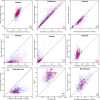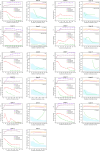Bile Chemistry During Ex Situ Normothermic Liver Perfusion Does Not Always Predict Cholangiopathy
- PMID: 38409681
- PMCID: PMC11115455
- DOI: 10.1097/TP.0000000000004944
Bile Chemistry During Ex Situ Normothermic Liver Perfusion Does Not Always Predict Cholangiopathy
Abstract
Background: Bile chemistry during normothermic ex situ liver perfusion (NESLiP) has been suggested to be an indicator of cholangiopathy. The normal range of biochemical variables in bile of livers undergoing NESLiP has not been defined, nor have published biliary viability criteria been assessed against instances of posttransplant nonanastomotic bile strictures (NASs).
Methods: The bile and perfusate chemistry of 200 livers undergoing NESLiP between February 1, 2018, and October 30, 2023, was compared. In addition, 11 livers that underwent NESLiP and later developed NAS were selected and their bile chemistry was also examined.
Results: In livers that did not develop cholangiopathy, concentrations of sodium, potassium, and chloride were slightly higher in bile than in perfusate, whereas the concentration of calcium was slightly lower. Bile was alkali and had a lower glucose concentration than perfusate. Cholangiocyte glucose reabsorption was shown to saturate at high perfusate concentrations and was more impaired in livers donated after circulatory death than in livers donated after brain death. Published criteria failed to identify all livers that went on to develop NASs.
Conclusions: A significant false-negative rate exists with current biliary viability criteria, probably reflecting the patchy and incomplete nature of the development of NASs in the biliary tree. The data presented here provide a benchmark for future assessment of bile duct chemistry during NESLiP.
Copyright © 2024 The Author(s). Published by Wolters Kluwer Health, Inc.
Conflict of interest statement
C.J.E.W., R.G., and A.J.B. participated in research design, writing the article, performing the research, and data analysis. L.S., C.F., S.S.U., R.B., and A.J.B. participated in performing the research. M.E.D.A. participated in writing the article and data analysis. C.J.E.W. received honoraria from OrganOx Ltd for lectures. A.J.B. is coholder of a patent on the circuit used in the OrganOx metra. The other authors declare no conflicts of interest.
Figures






Comment in
-
Comments on "Bile Chemistry During Ex Situ Normothermic Liver Perfusion Does Not Always Predict Cholangiopathy".Transplantation. 2024 Oct 1;108(10):e340-e341. doi: 10.1097/TP.0000000000005158. Epub 2024 Sep 25. Transplantation. 2024. PMID: 39320456 No abstract available.
References
-
- Patrono D, Lonati C, Romagnoli R. Viability testing during liver preservation. Curr Opin Organ Transplant. 2022;27:454–465. - PubMed
Publication types
MeSH terms
Grants and funding
LinkOut - more resources
Full Text Sources
Medical

